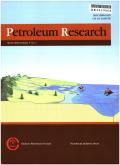Corrosion patterns and optimal materials of tubings in sulfur purification buried wells in the Sichuan Basin
IF 4
Q1 Earth and Planetary Sciences
引用次数: 0
Abstract
The study aims to explore the corrosion behaviors of tubings of different materials under the injection condition of sulfur-containing purification exhaust gas buried storage well and select a proper steel. A high-temperature and high-pressure autoclave was used to simulate the injection condition of sulfur-containing purification exhaust gas and carry out corrosion weight loss tests on N80 carbon steel, 13Cr stainless steel, and 825 nickel-based alloy steel under two different partial pressures of CO2 (2 and 5 MPa). Corrosion rate, the morphology of corrosion products, the morphology of cross-section of corrosion products, and local corrosion depth were explored and the corrosion life prediction and economic evaluation of tubings were performed. Under the simulated conditions, with the increase in CO2 partial pressure, the corrosion rates of N80 carbon steel, 13Cr stainless steel, and 825 nickel-based alloy steel increased from 0.0548 mm/a, 0.0172 mm/a, and 0.0013 mm/a to 0.102 mm/a, 0.025 mm/a, and 0.0034 mm/a. The corrosion products of the three steels were mainly FeCO3 and FeS and gradually increased with the increase in CO2 partial pressure. However, the connection among corrosion products was not dense and cracks and holes were observed in the corrosion product film. N80 steel mainly exhibited the uniform corrosion and its residual tensile strength and tensile safety factor decreased with the increase in service life. Safe service life decreased from 48a to 26a with the increase in CO2 partial pressure. Pitting corrosion occurred in 13Cr steel and the ultimate perforation life decreased from 6.05a to 3.36a with the increase in CO2 partial pressure. Based on the consideration of economy and field applicability, N80/825 bimetal composite tubing is recommended as the material of tubings.
四川盆地硫净化潜井管材腐蚀规律及优化研究
本研究旨在探讨含硫净化废气埋储井注入条件下不同材质油管的腐蚀行为,并选择合适的钢。采用高温高压高压釜模拟含硫净化废气喷射工况,对N80碳钢、13Cr不锈钢、825镍基合金钢在2、5 MPa不同CO2分压下进行了腐蚀失重试验。探讨了腐蚀速率、腐蚀产物形态、腐蚀产物截面形态和局部腐蚀深度,并对油管的腐蚀寿命进行了预测和经济评价。在模拟条件下,随着CO2分压的升高,N80碳钢、13Cr不锈钢和825镍基合金钢的腐蚀速率分别从0.0548 mm/a、0.0172 mm/a和0.0013 mm/a提高到0.102 mm/a、0.025 mm/a和0.0034 mm/a。三种钢的腐蚀产物主要为FeCO3和FeS,腐蚀产物随CO2分压的增加而逐渐增加。但腐蚀产物之间的连接不紧密,腐蚀产物膜中出现裂纹和孔洞。N80钢主要表现为均匀腐蚀,其残余抗拉强度和抗拉安全系数随使用寿命的增加而降低。随着CO2分压的增加,安全使用寿命从48a下降到26a。随着CO2分压的升高,13Cr钢出现点蚀,最终射孔寿命由6.05a降至3.36a。基于经济性和现场适用性的考虑,推荐采用N80/825双金属复合管作为油管材料。
本文章由计算机程序翻译,如有差异,请以英文原文为准。
求助全文
约1分钟内获得全文
求助全文
来源期刊

Petroleum Research
Earth and Planetary Sciences-Geology
CiteScore
7.10
自引率
0.00%
发文量
90
审稿时长
35 weeks
 求助内容:
求助内容: 应助结果提醒方式:
应助结果提醒方式:


